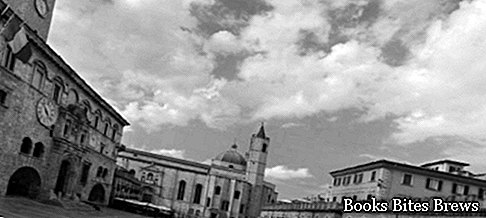What to see in Ascoli Piceno, one day itinerary including the main monuments and places of interest, including Palazzo Comunale with Pinacoteca and Palazzo dei Capitani del Popolo.
Tourist information
Located between the Tronto river and the Apennines, Ascoli Piceno is an industrial, commercial and agricultural center, as well as the provincial capital of the Marche region.
Initially it was a city of the Piceni subdued by the Romans in 286 BC, then it passed under the dominion of the Lombards, of the Duchy of Spoleto and finally of the Church, before becoming a free municipality in the twelfth century.
At the time of the Lordships, it fell again under the dominion of the Papal States.
The visit to the historic center starts from the Town Hall, located in Piazza Arringo and composed of two medieval buildings joined by a Baroque facade dating back to the seventeenth century.
The Town Hall houses the civic art gallery, where works by Van Dyck, Crivelli, Tiziano, Tintoretto, Sassoferrato, Guido Reni, Guercino and Turner are exhibited.
The Bishop's Palace, which houses the diocesan museum, and the Cathedral, built on the remains of a previous Roman construction, also overlook the Piazza dell'Arringo.
The facade of the Cathedral was built by Cola dell’Amatrice, while the bell tower is from the late sixteenth century.
Next to the Duomo is the twelfth-century octagonal baptistery, topped with a three-arched loggia.
In the adjacent via dei Bonaparte there is the Renaissance Palazzetto Bonaparte while, returning to the square, we find the eighteenth-century Palazzo Panichi, where the archaeological museum is housed.
In Piazza del Popolo, which is the heart of the city center, stands the thirteenth-century Palazzo dei Capitani del Popolo, reworked in 1518 by Cola dell’Amatrice.
Recommended readings- Fossombrone (Marche): what to see
- Marche: Sunday day trips
- Fermo (Marche): what to see
- Marche: what to see among valleys, hills and ancient villages
- Osimo (Marche): what to see
The building, dominated by a thirteenth-century tower, includes a Renaissance courtyard and a mighty portal.
Traveling along Corso Trento and Trieste you arrive in via del Trivio, where there is the Gothic Church of San Francesco, built between the thirteenth and sixteenth centuries, including three gothic-Venetian portals that open on the facade.
Interesting is the five-arched Loggia dei Mercanti, built in 1513.
Turning right along Corso Mazzini you will find the Church of Sant'Agostino, overlooking the square of the same name, built between the twelfth and fifteenth centuries.
Continuing the journey, in via Dari you come across the Church of San Venanzio, built between the twelfth and seventeenth centuries, to finally arrive in Rua Morelli, where the thirteenth-century Church of San Tommaso is located, which has the particularity of hosting the tower bell the oldest bell in the city.
What see
If you want to make an alternative itinerary, you can start from the Roman Theater in via Ricci and continue to Porta Gemina, in Piazza Cecco d’Ascoli, dating back to the first century BC. as an entrance to the city for those coming from via Salaria.
In the same square there is the Church of Santa Maria delle Grazie while, continuing to walk, taking Corso di Sotto, you will find in Via Soderini the Church of San Giacomo, built between the thirteenth and fourteenth centuries, with a remarkable Romanesque portal, little distant is the Palazzetto Longobardo, which is a typical example of proto-Romanesque dwelling dating back to the twelfth century, flanked by the Ercolani tower, which is the most interesting of the noble towers in the city.
Turning left on via Solestà, where towers and medieval houses overlook, you reach the Solestà bridge, from the Augustan era.
Going back towards the center you can admire the sixteenth century Church of San Pietro Martire in via delle Torri and, in Piazza Ventido Basso, the Romanesque church of Saints Vincenzo and Anastasio, built between the eleventh and fourteenth centuries, with a beautiful facade divided into 64 panels in the past frescoed, with a remarkable fourteenth-century Gothic portal embellished with Romanesque sculptures.
Continuing on the right along Corso del Tronto, in via Bartolomei you will find the Church of Santa Maria Inter Vineas, dating back to the twelfth and thirteenth centuries, while in Corso Mazzini, which you take turning right, you will come across the sixteenth-century Palazzo Malaspina, headquarters of the Gallery of Contemporary Graphic Art.
In Viale de Gasperi there is the church of San Vittore, built between the twelfth and thirteenth centuries, containing fourteenth-century frescoes.
Continuing along Lungo Castellano Sisto V and viale Pacifici Mazzoni, you reach via Sant’Angelo, where there is the Romanesque church of Sant’Angelo Magno, dating back to 1292 and equipped with a spire bell tower.
Nearby, about 12 km from the center, there is Colle San Marco, a place equipped with sports and tourist equipment, which is an excellent panoramic point of the city.
Among the main excursions to do is that of Montefiore dell 'Aso, a center located 53 km away which preserves the ancient medieval walls and the Collegiate Church of Santa Lucia, built in Romanesque style, where a remarkable polyptych painting made by Crivelli in 1473 is preserved.




